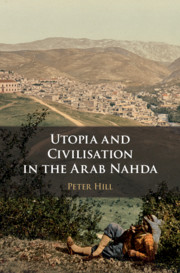Book contents
- Utopia and Civilisation in the Arab Nahda
- Utopia and Civilisation in the Arab Nahda
- Copyright page
- Contents
- Figures
- Acknowledgements
- Note on Transliteration, Dates and Abbreviations
- Introduction
- 1 Who Made the Nahda?
- 2 The Discourse of Civilisation
- 3 A Place in the World
- 4 An Arab Utopian
- Conclusions
- Bibliography
- Index
1 - Who Made the Nahda?
Published online by Cambridge University Press: 19 December 2019
- Utopia and Civilisation in the Arab Nahda
- Utopia and Civilisation in the Arab Nahda
- Copyright page
- Contents
- Figures
- Acknowledgements
- Note on Transliteration, Dates and Abbreviations
- Introduction
- 1 Who Made the Nahda?
- 2 The Discourse of Civilisation
- 3 A Place in the World
- 4 An Arab Utopian
- Conclusions
- Bibliography
- Index
Summary
Who made the Nahda? What social groups were involved in producing and supporting it? In what relation did these groups stand to other groups in their society, and to the wider historical processes that defined their era? These questions have not always been clearly posed in literary or intellectual histories of the Nahda, either in Arabic or in European languages. I do not aim to present here a comprehensive answer, or to survey all those who engaged in or supported Nahda cultural enterprises. Instead, I will examine in detail three clusters of particularly important Nahda literati. One emerged in Cairo in the 1830s and 1840s, in the Languages School run by Rifāʿa al-Ṭahṭāwī. A second took shape in the cultural societies of Beirut from the 1840s to the 1860s. The third arose in literary circles among Catholics in Aleppo in the 1850s and 1860s. It was individual members of these three clusters who produced the Nahda texts I analyse in detail in Chapters 2–4. The bulk of the present chapter is devoted, though, to examining each one of the clusters themselves, as a collectivity, or more precisely as what Raymond Williams calls a cultural ‘formation’: at once a circle of people, a set of cultural tendencies or practices, and – in some cases – a group of formal cultural institutions, such as schools, presses or learned societies. In each case, I will examine in detail who their members were, how they interacted with each other and what particular cultural practices they created or adapted to their needs.
- Type
- Chapter
- Information
- Utopia and Civilisation in the Arab Nahda , pp. 18 - 78Publisher: Cambridge University PressPrint publication year: 2020



